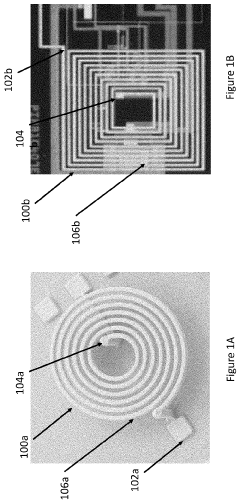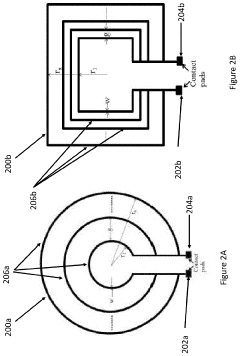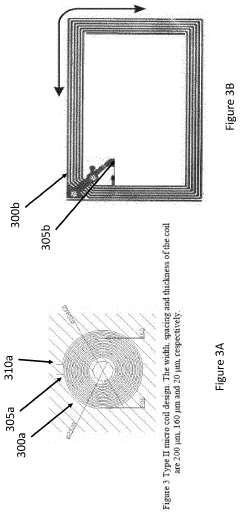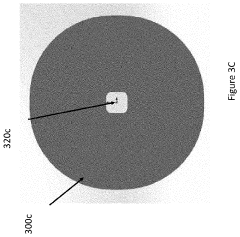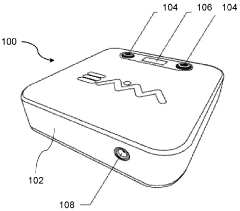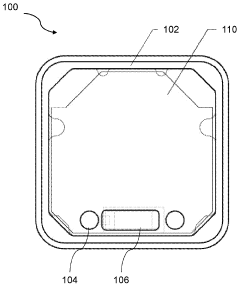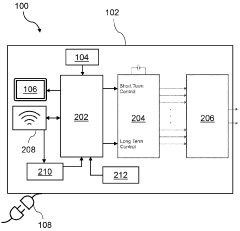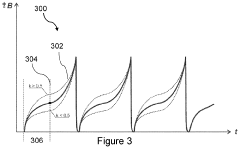The Role of PEMF Therapy in Augmenting Neurotherapy Techniques
AUG 11, 20259 MIN READ
Generate Your Research Report Instantly with AI Agent
Patsnap Eureka helps you evaluate technical feasibility & market potential.
PEMF and Neurotherapy Background
Pulsed Electromagnetic Field (PEMF) therapy and neurotherapy have emerged as promising approaches in the field of non-invasive neuromodulation. PEMF therapy utilizes electromagnetic fields to stimulate cellular activity and promote healing, while neurotherapy encompasses various techniques aimed at modulating brain function. The convergence of these two modalities represents a significant advancement in the treatment of neurological and psychiatric disorders.
The history of PEMF therapy dates back to the mid-20th century, with early applications focusing on bone healing and pain management. Over time, researchers discovered its potential in influencing neural activity, leading to its exploration in neurological applications. Neurotherapy, on the other hand, has its roots in neurofeedback techniques developed in the 1960s, which aimed to train individuals to self-regulate their brain activity.
As our understanding of brain function and neuroplasticity has evolved, so too has the potential for combining PEMF therapy with neurotherapy techniques. This integration offers a synergistic approach to addressing a wide range of neurological conditions, including depression, anxiety, ADHD, and chronic pain syndromes. The underlying principle is that PEMF can enhance the neuroplastic effects of traditional neurotherapy interventions, potentially leading to more rapid and sustained improvements in brain function.
Recent advancements in PEMF technology have led to the development of more precise and targeted stimulation protocols. These innovations allow for the modulation of specific neural networks and brain regions, aligning closely with the goals of neurotherapy. Concurrently, neurotherapy techniques have become more sophisticated, incorporating real-time neuroimaging and advanced signal processing methods to provide more accurate feedback and tailored interventions.
The combination of PEMF and neurotherapy represents a convergence of two distinct but complementary approaches to neuromodulation. PEMF therapy can potentially enhance the efficacy of neurotherapy by priming neural circuits for change, improving neural connectivity, and promoting neuroplasticity. This synergistic effect may lead to more robust and long-lasting therapeutic outcomes compared to either modality used in isolation.
As research in this field progresses, there is growing interest in understanding the mechanisms by which PEMF therapy augments neurotherapy techniques. Studies have begun to explore the effects of PEMF on neurotransmitter systems, synaptic plasticity, and neural network dynamics. These investigations are crucial for optimizing treatment protocols and expanding the range of applications for this combined approach.
The history of PEMF therapy dates back to the mid-20th century, with early applications focusing on bone healing and pain management. Over time, researchers discovered its potential in influencing neural activity, leading to its exploration in neurological applications. Neurotherapy, on the other hand, has its roots in neurofeedback techniques developed in the 1960s, which aimed to train individuals to self-regulate their brain activity.
As our understanding of brain function and neuroplasticity has evolved, so too has the potential for combining PEMF therapy with neurotherapy techniques. This integration offers a synergistic approach to addressing a wide range of neurological conditions, including depression, anxiety, ADHD, and chronic pain syndromes. The underlying principle is that PEMF can enhance the neuroplastic effects of traditional neurotherapy interventions, potentially leading to more rapid and sustained improvements in brain function.
Recent advancements in PEMF technology have led to the development of more precise and targeted stimulation protocols. These innovations allow for the modulation of specific neural networks and brain regions, aligning closely with the goals of neurotherapy. Concurrently, neurotherapy techniques have become more sophisticated, incorporating real-time neuroimaging and advanced signal processing methods to provide more accurate feedback and tailored interventions.
The combination of PEMF and neurotherapy represents a convergence of two distinct but complementary approaches to neuromodulation. PEMF therapy can potentially enhance the efficacy of neurotherapy by priming neural circuits for change, improving neural connectivity, and promoting neuroplasticity. This synergistic effect may lead to more robust and long-lasting therapeutic outcomes compared to either modality used in isolation.
As research in this field progresses, there is growing interest in understanding the mechanisms by which PEMF therapy augments neurotherapy techniques. Studies have begun to explore the effects of PEMF on neurotransmitter systems, synaptic plasticity, and neural network dynamics. These investigations are crucial for optimizing treatment protocols and expanding the range of applications for this combined approach.
Market Analysis for PEMF-Enhanced Neurotherapy
The market for PEMF-enhanced neurotherapy is experiencing significant growth, driven by increasing awareness of non-invasive treatment options for neurological disorders and the growing prevalence of mental health conditions. The global neurotherapy market, which includes PEMF therapy, is projected to expand at a robust rate over the next decade. This growth is fueled by factors such as the rising incidence of neurological disorders, advancements in neurotechnology, and a shift towards personalized medicine.
PEMF therapy, when integrated with traditional neurotherapy techniques, offers a unique value proposition in the market. It addresses the limitations of conventional treatments by potentially enhancing their efficacy and reducing side effects. This combination therapy is particularly appealing to patients seeking alternative or complementary treatments for conditions such as depression, anxiety, ADHD, and chronic pain.
The target market for PEMF-enhanced neurotherapy spans across various demographics, including aging populations dealing with cognitive decline, young adults struggling with stress-related disorders, and individuals with treatment-resistant neurological conditions. Healthcare providers, including neurologists, psychiatrists, and rehabilitation centers, represent key stakeholders in adopting this technology.
Geographically, North America currently leads the market due to advanced healthcare infrastructure and higher adoption rates of innovative medical technologies. However, Europe and Asia-Pacific regions are expected to witness rapid growth in the coming years, driven by increasing healthcare expenditure and growing awareness of mental health issues.
The market landscape is characterized by a mix of established medical device manufacturers and emerging neurotechnology startups. Major players are investing heavily in research and development to enhance the efficacy of PEMF devices and integrate them seamlessly with existing neurotherapy protocols. This has led to a surge in patent filings and clinical trials, indicating a highly competitive and innovation-driven market environment.
Challenges in the market include regulatory hurdles, as PEMF devices for neurotherapy applications require stringent approval processes. Additionally, the high cost of advanced PEMF systems and limited insurance coverage pose barriers to widespread adoption, particularly in emerging economies.
Despite these challenges, the market outlook remains positive. The increasing focus on mental health, coupled with the growing body of clinical evidence supporting PEMF therapy's efficacy in neurological applications, is expected to drive sustained market growth. As technology advances and costs decrease, PEMF-enhanced neurotherapy is poised to become a mainstream treatment option, potentially reshaping the landscape of neurological care.
PEMF therapy, when integrated with traditional neurotherapy techniques, offers a unique value proposition in the market. It addresses the limitations of conventional treatments by potentially enhancing their efficacy and reducing side effects. This combination therapy is particularly appealing to patients seeking alternative or complementary treatments for conditions such as depression, anxiety, ADHD, and chronic pain.
The target market for PEMF-enhanced neurotherapy spans across various demographics, including aging populations dealing with cognitive decline, young adults struggling with stress-related disorders, and individuals with treatment-resistant neurological conditions. Healthcare providers, including neurologists, psychiatrists, and rehabilitation centers, represent key stakeholders in adopting this technology.
Geographically, North America currently leads the market due to advanced healthcare infrastructure and higher adoption rates of innovative medical technologies. However, Europe and Asia-Pacific regions are expected to witness rapid growth in the coming years, driven by increasing healthcare expenditure and growing awareness of mental health issues.
The market landscape is characterized by a mix of established medical device manufacturers and emerging neurotechnology startups. Major players are investing heavily in research and development to enhance the efficacy of PEMF devices and integrate them seamlessly with existing neurotherapy protocols. This has led to a surge in patent filings and clinical trials, indicating a highly competitive and innovation-driven market environment.
Challenges in the market include regulatory hurdles, as PEMF devices for neurotherapy applications require stringent approval processes. Additionally, the high cost of advanced PEMF systems and limited insurance coverage pose barriers to widespread adoption, particularly in emerging economies.
Despite these challenges, the market outlook remains positive. The increasing focus on mental health, coupled with the growing body of clinical evidence supporting PEMF therapy's efficacy in neurological applications, is expected to drive sustained market growth. As technology advances and costs decrease, PEMF-enhanced neurotherapy is poised to become a mainstream treatment option, potentially reshaping the landscape of neurological care.
Current Challenges in PEMF-Neurotherapy Integration
The integration of Pulsed Electromagnetic Field (PEMF) therapy with neurotherapy techniques presents several significant challenges that researchers and clinicians are currently grappling with. One of the primary obstacles is the lack of standardization in PEMF protocols for neurological applications. The wide variety of PEMF devices, frequencies, intensities, and treatment durations makes it difficult to establish consistent and reproducible results across studies and clinical practices.
Another major challenge lies in understanding the precise mechanisms by which PEMF interacts with neural tissues. While there is evidence of PEMF's effects on cellular processes and neurotransmitter systems, the exact pathways and long-term impacts on brain function remain unclear. This knowledge gap hinders the development of targeted PEMF-neurotherapy protocols for specific neurological conditions.
The issue of dosage and treatment optimization also poses a significant hurdle. Determining the optimal PEMF parameters for different neurological disorders and individual patient profiles is a complex task. Factors such as the patient's age, the severity of the condition, and potential interactions with other treatments must be carefully considered, yet there is a scarcity of comprehensive guidelines for clinicians.
Furthermore, the integration of PEMF with existing neurotherapy techniques raises questions about potential synergies or conflicts. While some studies suggest that PEMF may enhance the efficacy of neurofeedback or cognitive training, others indicate possible interference effects. Resolving these uncertainties requires extensive research and clinical trials to establish best practices for combined therapies.
The lack of long-term safety data on PEMF use in neurotherapy is another pressing concern. Although PEMF is generally considered safe for short-term use, its effects on brain plasticity and function over extended periods are not fully understood. This gap in knowledge creates hesitation among healthcare providers and regulatory bodies in fully embracing PEMF as a standard neurotherapeutic tool.
Additionally, there are technical challenges in designing PEMF devices that can be seamlessly integrated with existing neurotherapy equipment. Issues such as electromagnetic interference with EEG recordings or other sensitive neurological monitoring devices need to be addressed to ensure accurate data collection and treatment delivery.
Lastly, the field faces challenges in educating healthcare professionals and the public about the potential benefits and limitations of PEMF in neurotherapy. Overcoming skepticism and misconceptions while promoting evidence-based practices requires concerted efforts in professional training and public outreach.
Another major challenge lies in understanding the precise mechanisms by which PEMF interacts with neural tissues. While there is evidence of PEMF's effects on cellular processes and neurotransmitter systems, the exact pathways and long-term impacts on brain function remain unclear. This knowledge gap hinders the development of targeted PEMF-neurotherapy protocols for specific neurological conditions.
The issue of dosage and treatment optimization also poses a significant hurdle. Determining the optimal PEMF parameters for different neurological disorders and individual patient profiles is a complex task. Factors such as the patient's age, the severity of the condition, and potential interactions with other treatments must be carefully considered, yet there is a scarcity of comprehensive guidelines for clinicians.
Furthermore, the integration of PEMF with existing neurotherapy techniques raises questions about potential synergies or conflicts. While some studies suggest that PEMF may enhance the efficacy of neurofeedback or cognitive training, others indicate possible interference effects. Resolving these uncertainties requires extensive research and clinical trials to establish best practices for combined therapies.
The lack of long-term safety data on PEMF use in neurotherapy is another pressing concern. Although PEMF is generally considered safe for short-term use, its effects on brain plasticity and function over extended periods are not fully understood. This gap in knowledge creates hesitation among healthcare providers and regulatory bodies in fully embracing PEMF as a standard neurotherapeutic tool.
Additionally, there are technical challenges in designing PEMF devices that can be seamlessly integrated with existing neurotherapy equipment. Issues such as electromagnetic interference with EEG recordings or other sensitive neurological monitoring devices need to be addressed to ensure accurate data collection and treatment delivery.
Lastly, the field faces challenges in educating healthcare professionals and the public about the potential benefits and limitations of PEMF in neurotherapy. Overcoming skepticism and misconceptions while promoting evidence-based practices requires concerted efforts in professional training and public outreach.
Existing PEMF-Neurotherapy Combination Approaches
01 PEMF devices for therapeutic applications
Pulsed Electromagnetic Field (PEMF) therapy devices are designed for various therapeutic applications. These devices generate electromagnetic fields to stimulate cellular repair and regeneration, potentially treating conditions such as pain, inflammation, and bone healing. The devices can be configured for different body parts and treatment protocols.- PEMF devices for therapeutic applications: Pulsed Electromagnetic Field (PEMF) therapy devices are designed for various therapeutic applications. These devices generate electromagnetic fields to stimulate cellular repair and regeneration, potentially alleviating pain and promoting healing in different parts of the body.
- PEMF therapy for pain management and tissue healing: PEMF therapy is utilized for managing pain and accelerating tissue healing. The electromagnetic pulses can penetrate deep into tissues, potentially reducing inflammation, improving circulation, and promoting the body's natural healing processes in conditions such as musculoskeletal injuries and chronic pain syndromes.
- Innovative PEMF delivery systems: Advanced PEMF delivery systems are being developed to enhance the efficacy and convenience of treatments. These innovations include wearable devices, targeted applicators, and systems that can be integrated into everyday objects, allowing for more consistent and user-friendly PEMF therapy applications.
- PEMF therapy in veterinary and agricultural applications: PEMF therapy is expanding into veterinary medicine and agriculture. Applications include treating injuries in animals, promoting plant growth, and improving crop yields. These non-invasive treatments offer potential benefits in animal health and sustainable farming practices.
- Combination of PEMF with other therapeutic modalities: Research is exploring the synergistic effects of combining PEMF therapy with other treatment modalities. This includes integration with light therapy, thermal treatments, and traditional medicine approaches to potentially enhance overall therapeutic outcomes and address complex health conditions more effectively.
02 PEMF therapy for pain management and tissue healing
PEMF therapy is utilized for pain management and tissue healing. The electromagnetic fields generated by PEMF devices can help reduce pain, decrease inflammation, and promote faster healing of injuries. This non-invasive treatment method is applied to various conditions, including musculoskeletal disorders and chronic pain syndromes.Expand Specific Solutions03 Combination of PEMF with other therapies
PEMF therapy is often combined with other treatment modalities to enhance therapeutic outcomes. This may include integration with light therapy, heat therapy, or other forms of electromagnetic stimulation. The synergistic effects of these combinations can potentially improve treatment efficacy for various health conditions.Expand Specific Solutions04 Portable and wearable PEMF devices
Advancements in PEMF technology have led to the development of portable and wearable devices. These compact units allow for convenient, at-home use and continuous treatment. Wearable PEMF devices can be designed for specific body parts, enabling targeted therapy while maintaining mobility and comfort for the user.Expand Specific Solutions05 PEMF therapy for cellular regeneration and anti-aging
PEMF therapy is being explored for its potential in cellular regeneration and anti-aging applications. The electromagnetic fields are thought to stimulate cellular metabolism, improve circulation, and enhance the body's natural healing processes. This may have implications for skin rejuvenation, wound healing, and overall cellular health.Expand Specific Solutions
Key Players in PEMF and Neurotherapy Fields
The field of PEMF therapy in neurotherapy techniques is in a growth phase, with increasing market size and technological advancements. The global PEMF therapy market is expected to expand significantly in the coming years, driven by growing applications in neurological disorders. While the technology is not yet fully mature, several key players are making strides in research and development. Companies like Venus Concept Ltd. and Regenesis Biomedical, Inc. are at the forefront, developing innovative PEMF devices for various medical applications. Other firms such as SofPulse, Inc. and Orthofix US LLC are also contributing to the field's advancement. The competitive landscape is diverse, with both established medical device companies and specialized PEMF therapy providers vying for market share and technological leadership.
Venus Concept Ltd.
Technical Solution: Venus Concept has developed advanced PEMF therapy devices specifically designed for neurotherapy applications. Their technology utilizes precise electromagnetic field patterns to stimulate neural tissue and enhance brain plasticity. The company's PEMF systems incorporate adaptive frequency modulation, allowing for personalized treatment protocols based on individual patient needs. Venus Concept's devices also feature real-time neuromonitoring capabilities, enabling therapists to track and adjust treatment efficacy during sessions[1][3]. The integration of cloud-based data analytics further supports long-term patient progress tracking and treatment optimization.
Strengths: Customizable treatment protocols, real-time monitoring, and data-driven optimization. Weaknesses: Potentially higher cost compared to simpler PEMF devices, may require specialized training for optimal use.
Regenesis Biomedical, Inc.
Technical Solution: Regenesis Biomedical has pioneered a PEMF therapy system that specifically targets neurological applications. Their technology utilizes pulsed radiofrequency energy (PRFE) to stimulate cellular repair and regeneration in neural tissues. The company's devices employ a unique waveform design that penetrates deeper into brain structures compared to traditional PEMF systems[2]. Regenesis' approach combines PEMF therapy with proprietary bioelectric stimulation techniques to enhance neurotransmitter production and synaptic plasticity. Their systems also incorporate adaptive treatment algorithms that adjust field strength and frequency based on real-time physiological feedback[4].
Strengths: Deep tissue penetration, combined PEMF and bioelectric stimulation, adaptive treatment protocols. Weaknesses: May have a steeper learning curve for practitioners, potentially higher initial investment.
Core PEMF-Neurotherapy Synergy Mechanisms
Pulsed Electromagnetic Field Devices Integrated into Adjustable Clothing
PatentPendingUS20230104434A1
Innovation
- A pulsed electromagnetic field device integrated into wearable clothing, using arrays of planar microcoils that generate controlled, homogenous magnetic fields, allowing for comfortable, long-term use and targeted treatment of various brain-related disorders and conditions.
A pulsed electromagnetic field apparatus and method for generating frequencies
PatentWO2024127242A1
Innovation
- A PEMF apparatus with a pulse generator and electromagnetic field generation means that uses modified sawtooth waveforms with pre-stress and relaxation periods, and quasi-sine signals with pulse width modulation, along with a feedback circuit for frequency stability and precision, and a bifilar antenna for scalar wave generation.
Regulatory Framework for PEMF-Neurotherapy Devices
The regulatory framework for PEMF-Neurotherapy devices is a complex and evolving landscape that plays a crucial role in shaping the development, approval, and implementation of these innovative therapeutic tools. In the United States, the Food and Drug Administration (FDA) is the primary regulatory body overseeing PEMF devices used in neurotherapy applications. These devices are typically classified as Class II medical devices, requiring a 510(k) premarket notification submission to demonstrate substantial equivalence to a legally marketed predicate device.
The FDA's regulatory approach for PEMF-Neurotherapy devices focuses on ensuring safety and efficacy through rigorous clinical trials and post-market surveillance. Manufacturers must provide substantial evidence of the device's safety and effectiveness, including data from well-controlled clinical studies. The agency also requires comprehensive documentation on device design, manufacturing processes, and quality control measures.
In the European Union, PEMF-Neurotherapy devices fall under the purview of the Medical Device Regulation (MDR). The MDR imposes stricter requirements for clinical evidence and post-market surveillance compared to its predecessor, the Medical Device Directive. Manufacturers seeking CE marking for their devices must demonstrate compliance with essential safety and performance requirements, conduct clinical investigations, and implement a robust quality management system.
Internationally, regulatory frameworks for PEMF-Neurotherapy devices vary significantly. Some countries have adopted regulations similar to those in the US or EU, while others have less stringent requirements or lack specific regulations for these devices. This regulatory diversity presents challenges for global market access and harmonization efforts.
As the field of PEMF therapy in neurotherapy continues to advance, regulatory bodies are adapting their frameworks to address emerging technologies and applications. This includes developing guidance documents for novel PEMF-Neurotherapy combinations and considering the integration of artificial intelligence and machine learning in device control and treatment optimization.
Regulatory compliance also extends to electromagnetic compatibility (EMC) standards, ensuring that PEMF-Neurotherapy devices do not interfere with other medical equipment or electronic devices in clinical settings. Manufacturers must adhere to specific EMC standards and conduct appropriate testing to demonstrate compliance.
The evolving regulatory landscape for PEMF-Neurotherapy devices underscores the need for ongoing collaboration between regulatory agencies, manufacturers, and clinical researchers. This collaborative approach aims to strike a balance between fostering innovation and ensuring patient safety, ultimately shaping the future of PEMF therapy in augmenting neurotherapy techniques.
The FDA's regulatory approach for PEMF-Neurotherapy devices focuses on ensuring safety and efficacy through rigorous clinical trials and post-market surveillance. Manufacturers must provide substantial evidence of the device's safety and effectiveness, including data from well-controlled clinical studies. The agency also requires comprehensive documentation on device design, manufacturing processes, and quality control measures.
In the European Union, PEMF-Neurotherapy devices fall under the purview of the Medical Device Regulation (MDR). The MDR imposes stricter requirements for clinical evidence and post-market surveillance compared to its predecessor, the Medical Device Directive. Manufacturers seeking CE marking for their devices must demonstrate compliance with essential safety and performance requirements, conduct clinical investigations, and implement a robust quality management system.
Internationally, regulatory frameworks for PEMF-Neurotherapy devices vary significantly. Some countries have adopted regulations similar to those in the US or EU, while others have less stringent requirements or lack specific regulations for these devices. This regulatory diversity presents challenges for global market access and harmonization efforts.
As the field of PEMF therapy in neurotherapy continues to advance, regulatory bodies are adapting their frameworks to address emerging technologies and applications. This includes developing guidance documents for novel PEMF-Neurotherapy combinations and considering the integration of artificial intelligence and machine learning in device control and treatment optimization.
Regulatory compliance also extends to electromagnetic compatibility (EMC) standards, ensuring that PEMF-Neurotherapy devices do not interfere with other medical equipment or electronic devices in clinical settings. Manufacturers must adhere to specific EMC standards and conduct appropriate testing to demonstrate compliance.
The evolving regulatory landscape for PEMF-Neurotherapy devices underscores the need for ongoing collaboration between regulatory agencies, manufacturers, and clinical researchers. This collaborative approach aims to strike a balance between fostering innovation and ensuring patient safety, ultimately shaping the future of PEMF therapy in augmenting neurotherapy techniques.
Safety and Efficacy Considerations
The integration of Pulsed Electromagnetic Field (PEMF) therapy with neurotherapy techniques presents a promising avenue for enhancing therapeutic outcomes in various neurological conditions. However, the safety and efficacy of this combined approach require careful consideration and evaluation.
From a safety perspective, PEMF therapy has been widely studied and is generally considered safe when used within established parameters. The non-invasive nature of PEMF reduces the risk of complications associated with more invasive treatments. Nevertheless, potential contraindications exist, particularly for patients with implanted electronic devices such as pacemakers or deep brain stimulators. Pregnant women and individuals with certain metal implants may also need to exercise caution.
Efficacy considerations for PEMF in neurotherapy are multifaceted. Numerous studies have demonstrated PEMF's ability to modulate neural activity, enhance neuroplasticity, and promote cellular repair. When combined with traditional neurotherapy techniques, PEMF may potentiate the effects, leading to improved outcomes in conditions such as depression, anxiety, and cognitive disorders.
The dosage and frequency of PEMF application in neurotherapy contexts require careful calibration. Optimal treatment protocols may vary depending on the specific neurological condition being addressed and individual patient factors. Standardization of treatment parameters across different PEMF devices and neurotherapy modalities remains a challenge, potentially affecting the consistency of outcomes.
Long-term effects of combined PEMF and neurotherapy treatments warrant further investigation. While short-term studies have shown promising results, the sustained benefits and potential cumulative effects of prolonged use need to be thoroughly assessed. This includes monitoring for any delayed adverse reactions or adaptations that may occur with extended treatment periods.
Quality control and regulatory compliance are crucial aspects of safety and efficacy considerations. As PEMF devices become more widely available, ensuring adherence to manufacturing standards and proper calibration is essential. Additionally, practitioner training in the appropriate use of PEMF in conjunction with neurotherapy techniques is vital to maximize therapeutic benefits while minimizing risks.
Patient selection criteria play a significant role in both safety and efficacy outcomes. Identifying suitable candidates who are most likely to benefit from combined PEMF and neurotherapy approaches can enhance overall treatment success rates. This may involve considering factors such as the patient's medical history, specific neurological condition, and potential interactions with other ongoing treatments.
In conclusion, while the integration of PEMF therapy with neurotherapy techniques shows great promise, a balanced approach to safety and efficacy is paramount. Ongoing research, rigorous clinical trials, and post-treatment monitoring will be essential in refining protocols and establishing best practices for this innovative therapeutic combination.
From a safety perspective, PEMF therapy has been widely studied and is generally considered safe when used within established parameters. The non-invasive nature of PEMF reduces the risk of complications associated with more invasive treatments. Nevertheless, potential contraindications exist, particularly for patients with implanted electronic devices such as pacemakers or deep brain stimulators. Pregnant women and individuals with certain metal implants may also need to exercise caution.
Efficacy considerations for PEMF in neurotherapy are multifaceted. Numerous studies have demonstrated PEMF's ability to modulate neural activity, enhance neuroplasticity, and promote cellular repair. When combined with traditional neurotherapy techniques, PEMF may potentiate the effects, leading to improved outcomes in conditions such as depression, anxiety, and cognitive disorders.
The dosage and frequency of PEMF application in neurotherapy contexts require careful calibration. Optimal treatment protocols may vary depending on the specific neurological condition being addressed and individual patient factors. Standardization of treatment parameters across different PEMF devices and neurotherapy modalities remains a challenge, potentially affecting the consistency of outcomes.
Long-term effects of combined PEMF and neurotherapy treatments warrant further investigation. While short-term studies have shown promising results, the sustained benefits and potential cumulative effects of prolonged use need to be thoroughly assessed. This includes monitoring for any delayed adverse reactions or adaptations that may occur with extended treatment periods.
Quality control and regulatory compliance are crucial aspects of safety and efficacy considerations. As PEMF devices become more widely available, ensuring adherence to manufacturing standards and proper calibration is essential. Additionally, practitioner training in the appropriate use of PEMF in conjunction with neurotherapy techniques is vital to maximize therapeutic benefits while minimizing risks.
Patient selection criteria play a significant role in both safety and efficacy outcomes. Identifying suitable candidates who are most likely to benefit from combined PEMF and neurotherapy approaches can enhance overall treatment success rates. This may involve considering factors such as the patient's medical history, specific neurological condition, and potential interactions with other ongoing treatments.
In conclusion, while the integration of PEMF therapy with neurotherapy techniques shows great promise, a balanced approach to safety and efficacy is paramount. Ongoing research, rigorous clinical trials, and post-treatment monitoring will be essential in refining protocols and establishing best practices for this innovative therapeutic combination.
Unlock deeper insights with Patsnap Eureka Quick Research — get a full tech report to explore trends and direct your research. Try now!
Generate Your Research Report Instantly with AI Agent
Supercharge your innovation with Patsnap Eureka AI Agent Platform!
